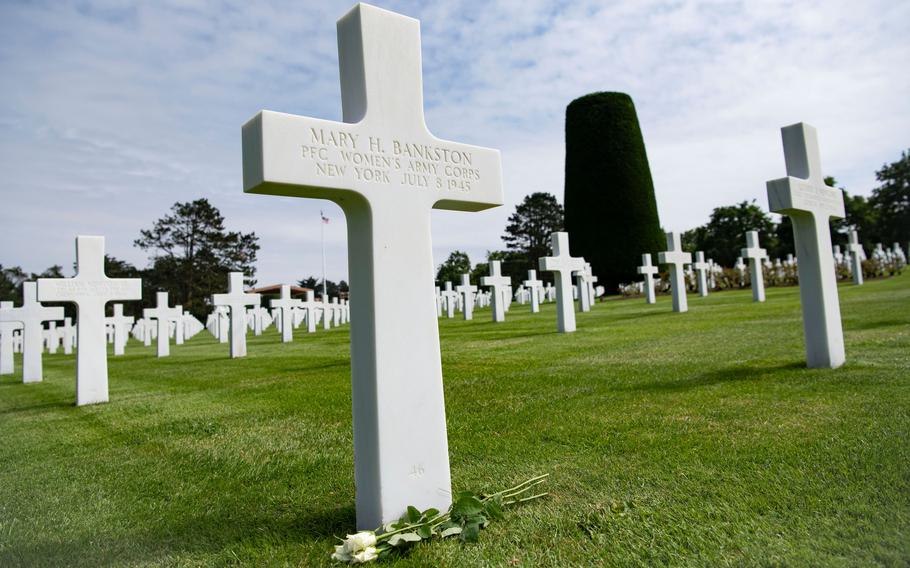
The grave of Pvt. Mary Bankston, one of four women buried at Normandy American Cemetery, as seen on June 1, 2024. (Phillip Walter Wellman/Stars and Stripes)
COLLEVILLE-SUR-MER, France — Among the roughly 9,400 graves at Normandy American Cemetery are those of four women: Mary Bankston, Mary Barlow, Dolores Browne and Elizabeth Richardson.
They’re a reminder of the less-heralded roles American women played overseas during World War II.
Bankston and Barlow, both privates, and Browne, a sergeant, served with the Women’s Army Corps, a special component created during the war to allow women to serve in noncombat roles.
The Corps was segregated and included the all-Black 6888th Central Postal Directory Battalion, to which the women were assigned.
In early 1945, the Six Triple Eight, as it was known, deployed to the United Kingdom with a mission to clear a backlog of undelivered letters and packages that had been piling up in warehouses since D-Day, the previous June.
At the time, mail was the only way for service members abroad to communicate with their loved ones back home, and the backlog was said to be affecting troop morale.
“Just think about how many times a day you look at your phone or expect a phone call,” said retired Army Col. Edna W. Cummings, who has spent about a decade working to get recognition for the unit. “Once that final communication with loved ones is interrupted, it causes troop morale to plummet.”
The battalion’s soldiers worked long shifts in bleak warehouses, where rats had eaten through some of the estimated 17 million items of mail. The buildings were kept dark so that the enemy couldn’t detect them.
Cummings believed the women were set up to fail like other units that had attempted to clear the backlog before them.
But under the leadership of Maj. Charity Adams, the Six Triple Eight devised a system to tackle the problem, which included creating a card index of names and working round the clock in shifts to maximize efficiency, according to the U.S. Army Center of Military History.
Not only did they complete their mission, but they also did so three months ahead of schedule. The success allowed the unit to transfer to Rouen, France, in May 1945 to clear a postal jam there.
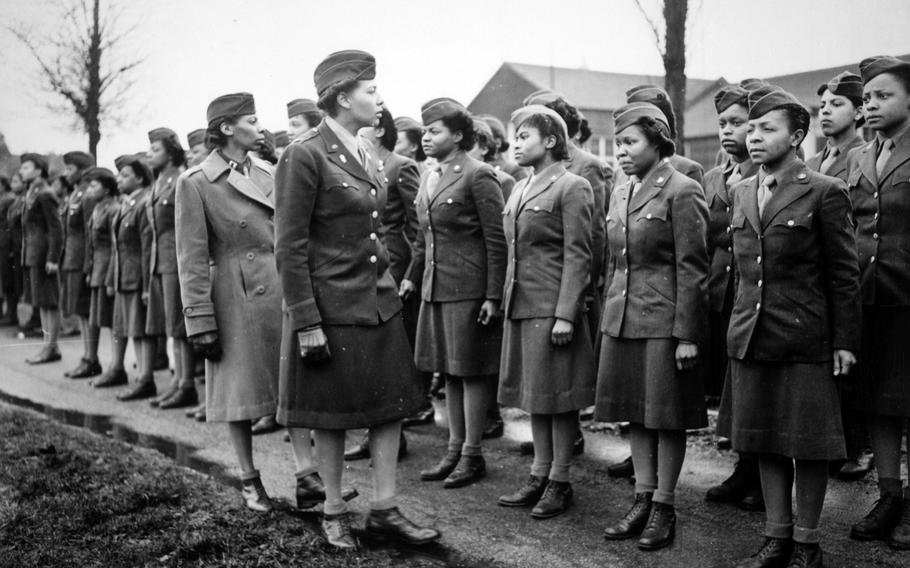
Somewhere in England in February 1945, Maj. Charity E. Adams and Capt. Abbie N. Campbell inspect the first contingent of Black members of the Women's Army Corps assigned to overseas service. (National Archives)
It was in Rouen two months later when “the Three B’s,” as they were known, were involved in a fatal jeep accident. In her book “One Woman’s Army,” Adams wrote that the trio had been returning from a social trip to another installation when the accident happened.
The two privates were killed the day of the accident. Browne lived for another five days before succumbing to her injuries. All were in their early 20s.
Bankston and Barlow belonged to the battalion’s entertainment troupe and put on performances in their free time. Not much else is known about any of the young women, whose remains were relocated to Normandy American Cemetery in 1948 with their families’ consent.
While they faced segregation during their military service, they are honored at the cemetery in the same manner as all other service members regardless of rank, gender, race, religion or country of origin.
In 2022, their entire battalion was presented the Congressional Gold Medal, the nation’s highest civilian award, in large part thanks to Cummings’ advocacy.
“They did something that no one else could get done,” Cummings said. “Restoring a vital communication link in a combat environment is a heroic deed, and that’s what the Six Triple Eight did.”
Unlike the other three women, Elizabeth Richardson wasn’t in the military.
As a member of the American Red Cross clubmobile unit, she helped serve coffee and donuts to American service members in England and France.
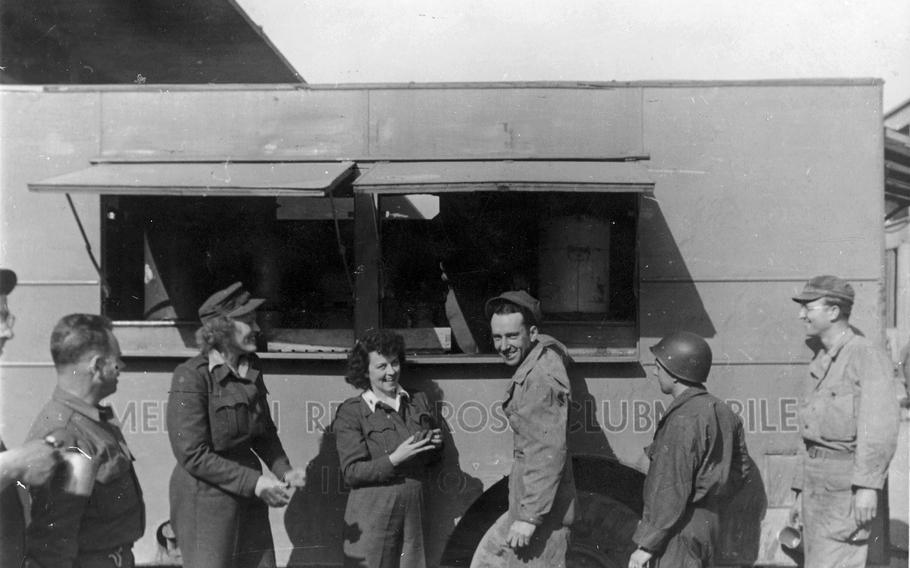
Elizabeth Richardson, left, with smiling troops in front of a clubmobile in Normandy, France. Richardson sent this photo to her parents on June 4, 1945, noting that the blur in her left hand is a donut. (James H. Madison)
The clubmobiles were vehicles converted into mobile kitchens. The first ones landed in Normandy just weeks after the Allied invasion. In some instances, they operated just behind the front lines.
While coffee and donuts might not sound like much, James H. Madison, a historian at Indiana University, said the clubmobile women were “exceedingly important.”
“For many soldiers, these women were the embodiment of home, and that, of course, is what these guys were fighting for,” Madison said. “They’re not fighting to destroy fascism. They’re not fighting to raise the American flag. They are fighting for home.”
Madison first became aware of Richardson during a visit to Normandy American Cemetery, as he was looking for graves of “boys” from his home state of Indiana. He admits he was shocked to find one of a woman, and it piqued his curiosity.
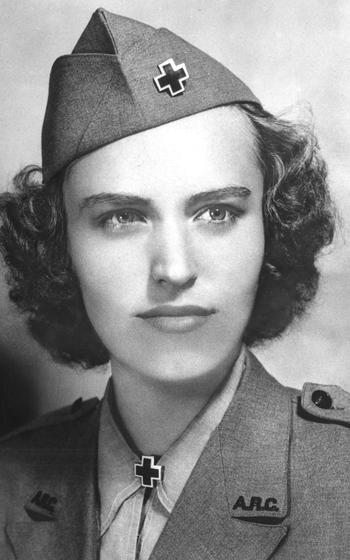
Elizabeth Richardson, pictured in 1944, was an American Red Cross volunteer who served in a clubmobile unit. The clubmobiles were converted vehicles that served coffee and donuts to U.S. soldiers. Richardson is buried in Normandy American Cemetery. (Courtesy Anne Bodle Schuknecht)
Upon returning home, he began researching Richardson. Her brother provided him with a trove of information, including old diaries, which revealed how she formed a bond with American soldiers who fought on the front lines.
She had deep conversations with them about what they were feeling and experiencing. Among them were airborne soldiers, whom she spoke with just before they left for Operation Market Garden in the Netherlands. Several thousand Americans died in the fighting.
“She came to know war as well as anyone can know it who has not actually been in combat,” Madison said. “She knew the necessity for the war, but she also knew the tragedies of it.”
Richardson also met American prisoners of war in France after they were liberated from Nazi confinement.
“She saw them and served them coffee and donuts when they got off their plane coming back from Germany,” said Madison, who went on to write a book about Richardson. “That was the nature of her war experience. It’s a heroic experience, and I think she deserves all the honor.”
On July 25, 1945, Richardson was heading to Paris on a small plane when it crashed near Rouen, killing her and the pilot.
“It’s important to remember that sacrifice came from all corners of America,” said Charles Djou, secretary of the American Battle Monuments Commission, which oversees Normandy American Cemetery. “It wasn’t just soldiers who made the ultimate sacrifice for our nation.”
And among those who were service members, it’s important to remember that not all were men, said Kim Guise, a senior curator at the National World War II Museum in New Orleans.
“It’s wonderful that many Americans know about Rosie the Riveter and the important work that women were doing in factories, here on the homefront,” Guise said in a phone interview. “But a lot of people don’t realize that women served in such large numbers in the military during World War II.”
The Women’s Army Corps had more than 150,000 volunteers, according to official figures.
“It’s our job now to tell those stories,” Guise said. “There are some stories that are very well-known from World War II and for good reason, but if you look below the surface just a little, there are these other individuals and other stories that are just waiting to be told.”
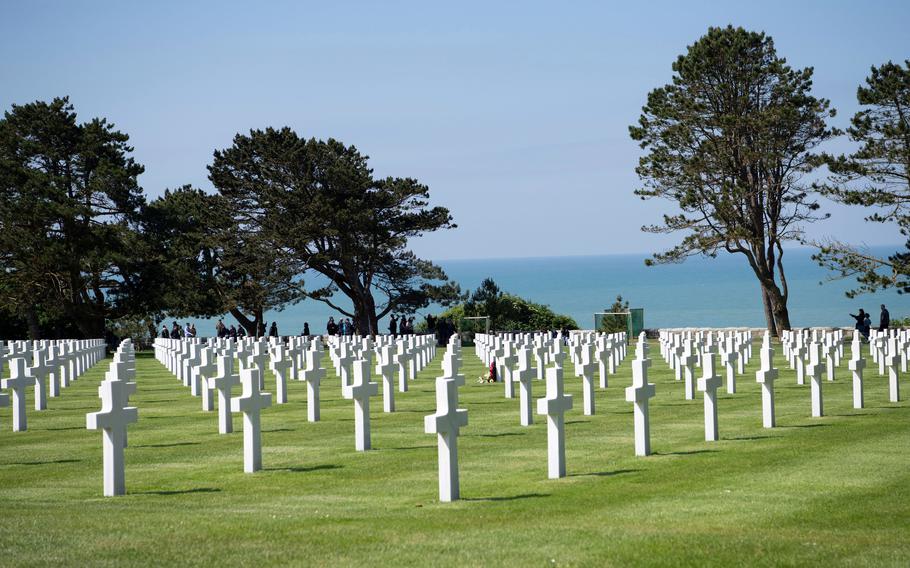
Normandy American Cemetery, which sits on a cliff overlooking Omaha Beach in Colleville-sur-Mer, France, has roughly 9,400 graves, four of which belong to women. (Phillip Walter Wellman/Stars and Stripes)